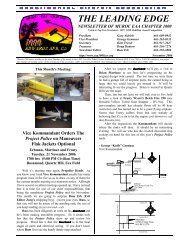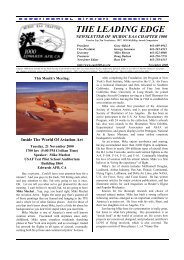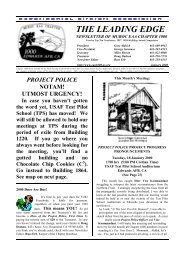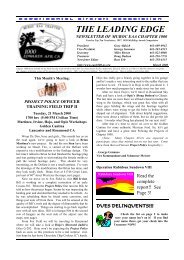March - EAA Chapter 1000 Home Page
March - EAA Chapter 1000 Home Page
March - EAA Chapter 1000 Home Page
Create successful ePaper yourself
Turn your PDF publications into a flip-book with our unique Google optimized e-Paper software.
THE LEADING EDGE<br />
Skywagon access panels, but had a letter already drafted on<br />
his computer that he would send me if only I would give<br />
him my credit card number. After authorizing a $72<br />
charge, the letter was on my fax machine the same day!<br />
Bill attached it to a Form 337, along with the Cessna Parts<br />
Manual pages that showed the installation in the later<br />
model airplanes. After only minor changes, Mr. Barnard<br />
affixed his official stamp of approval.<br />
Back to the warm Friday afternoon...Since the<br />
manual's line drawing of the late-model fuselage skin with<br />
the access hole was somewhat lacking in clarity I had<br />
secured a digital picture of someone's installation. That<br />
and the pilot-drilled holes in the doubler plate gave us a<br />
rough idea of where to start cutting the hole. As the saw<br />
began gnawing into the robust skin of the tail I had visions<br />
of terrible things happening...rampant corrosion unveiled,<br />
undocumented fuel lines torn asunder, or just a Simpsonsesque<br />
spectacular explosion. Alas, we discovered, just like<br />
Geraldo Rivera, that there was nothing to fear inside. As<br />
the pictures show, we picked the right place to drill/cut and<br />
under Bill's skilled hands the hole was gradually enlarged<br />
to the proper dimensions and the doubler was fitted. Then,<br />
using an array of tools that would make Tim Taylor<br />
salivate, the rivet holes were located and back-drilled just<br />
before the sunset.<br />
Saturday afternoon, the infamous desert winds picked<br />
up to over 40 knots. The Skywagon's trembling turned into<br />
significant shaking. I tied a wing to the trailer hitch of the<br />
Accord/tiedown anchor just to give Bill a steady enough<br />
platform to keep him from turning the other side of the tail<br />
into Swiss cheese. Despite the howling sandstorm we were<br />
able to complete the second installation, using the first as a<br />
guide. The final challenge was the requirement to fabricate<br />
tapered shims from .032 stock to fill the gaps caused by<br />
wedging the doublers under existing fuselage stringers.<br />
Bill had to buy a new tool for that one (DAMN the luck!).<br />
Well, the pictures tell the rest of the story. The<br />
Fightin' Skywagon is sporting enhanced tail access (don't<br />
go there...) Oh yeah, in addition to the low rudder cable<br />
tension, I discovered bushings in bellcranks and springs on<br />
the tailwheel cables that were worn beyond limits with no<br />
evidence of service since 1977. The new springs were at<br />
least an inch shorter after installation than the original<br />
springs.<br />
Eventually, the original objective turnbuckles were<br />
adjusted and the Fightin’ Skywagon was returned to<br />
service, sporting new access panels to the envy of other<br />
Skywagons everywhere.<br />
- Gary Aldrich<br />
Dr. Irvine opens the patient as concerned guardian<br />
Aldrich looks on<br />
Opening up the hole to match the provided doubler<br />
Doctor, prepare the patient for initial incision<br />
PAGE 4






